Introduction
Historical Note: Iowa became a state on December 28, 1846.
Recently, I just happened to watch the 1941 movie “Western Union”. The plot, as the title suggests, has its characters working for Western Union in 1861, making the final link of the transcontinental telegraph lines from Omaha, Nebraska (just across the river from Council Bluffs, Iowa) to Salt Lake City. It got me to thinking what a pivotal time in history that it was for the people of that era. Abraham Lincoln was president, the Civil War had started, and the first coast-to-coast electronic communications system was being established.
America in the mid-1800’s was just as transformational for the people of that time, as our time is for us right now. Within my lifetime we went from landline dial phones to a small portable handheld device that not only will connect us with just about anyone on the planet, but it also gives us instant access to more information than the people back then could ever imagine. Yet, many of us simply use this tech for the mundane; like letting everyone know what we had for breakfast (and take a photo of that breakfast to send along as well).
With Western Union finishing the transcontinental telegraph, information that used to take days to weeks (carried by written word via horseback), could now be transmitted in minutes. Western Union would go on to form the Russian–American Telegraph Company with the aim to link America to Europe via Alaska to Siberia. They would give up on that plan when another company, Atlantic Telegraph Company, took a more daring approach by laying the first transatlantic undersea cable in 1866. An amazing engineering feat for that era. The cable under the ocean did for global communications what the telegraph poles across the country did for America; forever change the personal, commercial, and political relations between people across these great distances.
August and Elisabeth
When we last left off with the Matthiensen family, we followed the incredible story of new immigrants Elisabeth “Lise” Hopp and Heinrich August Matthiensen. Both of these folks came over to America from Schleswig-Holstein; a geopolitically disputed region that on at least two occasions had Denmark and Germany warring over who owned it. August fought in one of those wars.
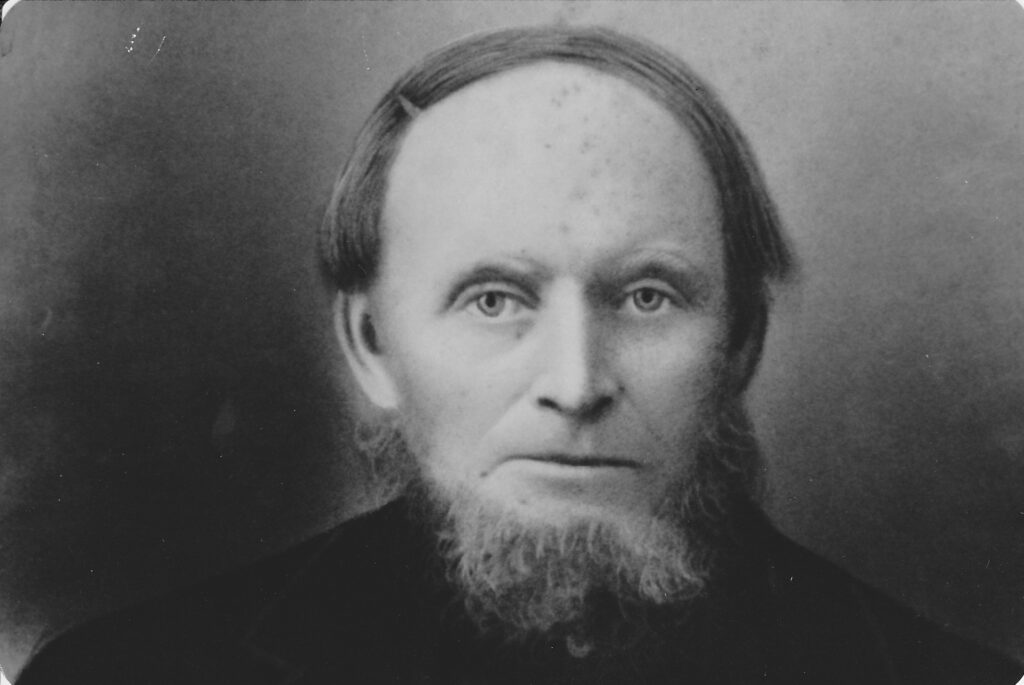
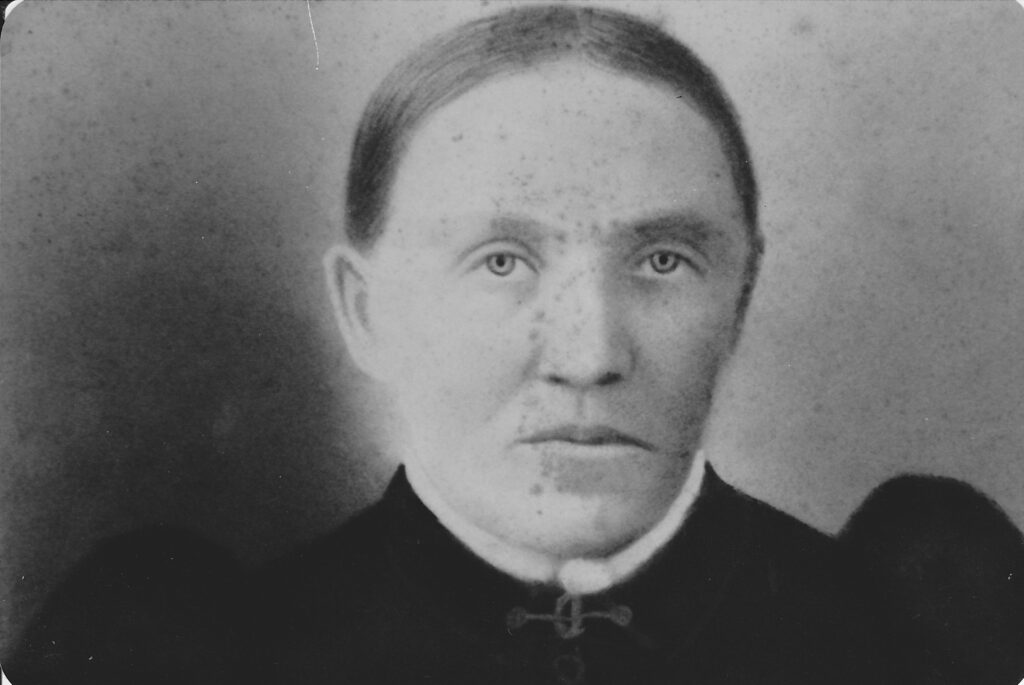
August and Lise Matthiensen – Photos from my parent’s archive
Things were tough in their post-war homeland. So much so, that they, and so many others, would leave everything behind, risk a long and dangerous transatlantic crossing on a wooden sail-powered ship, and arrive in a country for which they could not speak the language and knew little about. But that was only the beginning. After landing on the shores of America, they would travel another 1,200 miles overland west to Iowa.
I recently found a passenger list for a ship named Devonshire that arrived in New York harbor on August 12, 1850 with a 11 year old Elisabeth Hopp on board. This very closely corresponds with the timeframe of Lise’s birthdate (January 8, 1840). It could very well be her. According to notes on a photograph, August came to America in 1861 when he was 30 years old.

A painting of the Devonshire found on the internet
While they may have arrived 11 years apart, August and Lise would eventually meet one another in western Iowa, and would establish a new life for themselves as farmers. They had four daughters and one son.
This is the story of that one son, Christian Adolph Matthiensen, and the young lady who became his partner in life, Bertha M Schneckloth. Bertha’s parents, Henry and Amalia, were also immigrants from Schleswig-Holstein.
Historical Note: The Civil War ended on April 9, 1865. President Lincoln was assassinated just six days later.
Adolph
Christian Adolph Matthiensen was born on February 16, 1872; just about exactly 9 months to the date of his parent’s marriage. He was the oldest of the five children. Like his father August, Adolph was known by his middle name.
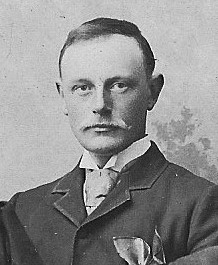
Adolph as a young man
Adolph’s four sisters would marry and have families of their own. They and their families mostly stayed in farming. A brief biography of these sisters was outlined in “PPP – The Matthiensen Family – Part 2 August’s Will”.
There are so many fascinating finds when doing this work. Relating these historical facts as a story is gratifying work, but seeing the records from which these stories are told is like finding hidden treasure. So, I would like to pause here to share a few examples.
Below is an image of the U.S. Evangelical Lutheran Church in America Church Records for Adolph’s baptism. This is a record from the Ancestry website. Entry #6 shows that Adolph was baptized on September 1, 1872, when he was just about six months old. Note that the language in the hand written column headers and other words like the days of the week are in German.

This church record book is 178 pages long. On Ancestry, you can flip through every page, which is great because sometimes going to the beginning of the book can reveal valuable information about the source document. It is pretty remarkable that people have taken the time to scan each of these pages and make them available to others.
The Salem German Evangelical Lutheran Congregation of the Unaltered Augsburg Confession in Plumer’s Settlement in Mills County, Iowa (how’s that for a name?) was founded in 1867. So, the church was only 5 years old when Adolph was baptized. The original log cabin church was later replaced with a brick church, that (while now with a coat of concrete) still stands there today.
See it here https://www.plumersettlement.org/salemlutheran.html
Historical Note: The Augsburg Confession, also known as the Augustan Confession, is the primary confession of faith of the Lutheran Church, and one of the most important documents of the Protestant Reformation.
It is important to note that back then most children were born at home, and as such there was no birth certificate issued. However, Adolph’s parents did receive this beautiful baptismal certificate, which I found among my parent’s belongings.
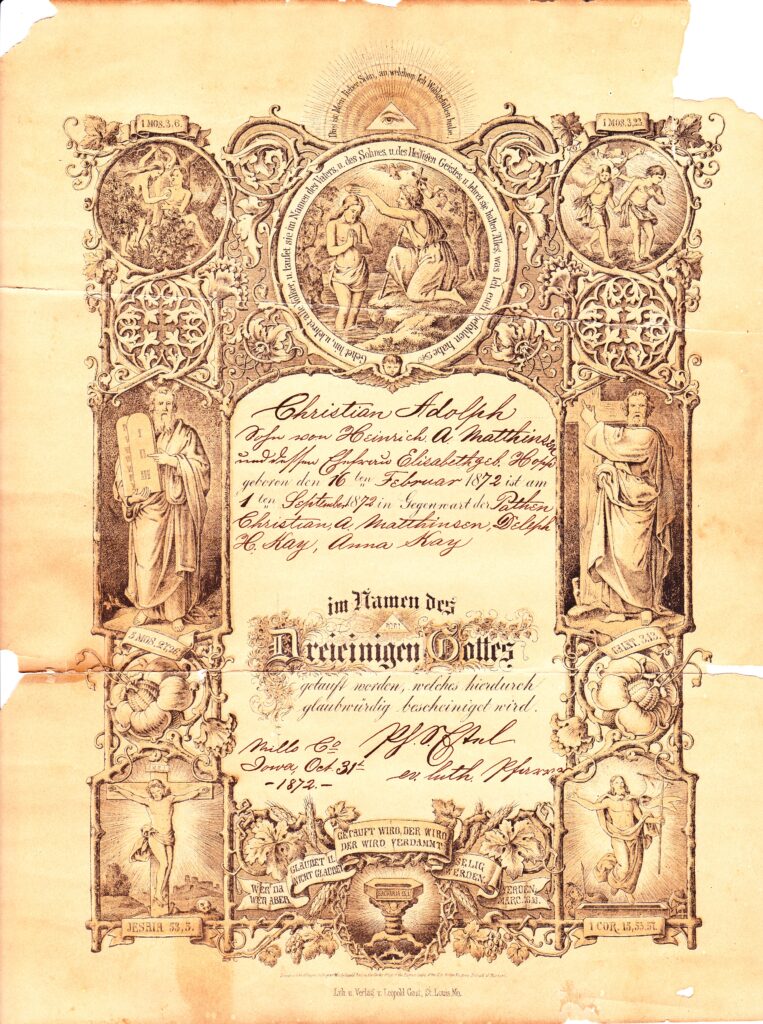
This fragile 9 X 11 inch piece of paper, is a beautiful document, rich in very detailed iconography and biblical verse in German. At the top it reads, “Das ist mein lieber Sohn an dem ich Wohlgefallen habe”, which translates to “This is my beloved Son, in whom I am well pleased.”
Historical Note: While the ‘eye’ symbolism (at the top of the certificate) can be found in nonreligious traditions like freemasonry, it has also been known as the Eye of Providence or the all-seeing eye of God. During the Renaissance, and up into this time period, Christianity associated the ‘eye’ with the concept of Divine Providence, and the triangle represented the Christian Trinity.
Not having a birth certificate was not a problem back in the day. However, in 1935 the Social Security Act was signed into law by President Roosevelt. To register and receive benefits, you needed some documentation to establish citizenship, like a birth certificate. This entire generation of rural home-birthed people found themselves in a pickle. A bureaucratic path had to be created to acquire some acceptable form of documentation for registration in the system. For Adolph, this baptismal record served as a reference document for the State of Iowa to issue him a “Delayed Birth Certificate”.
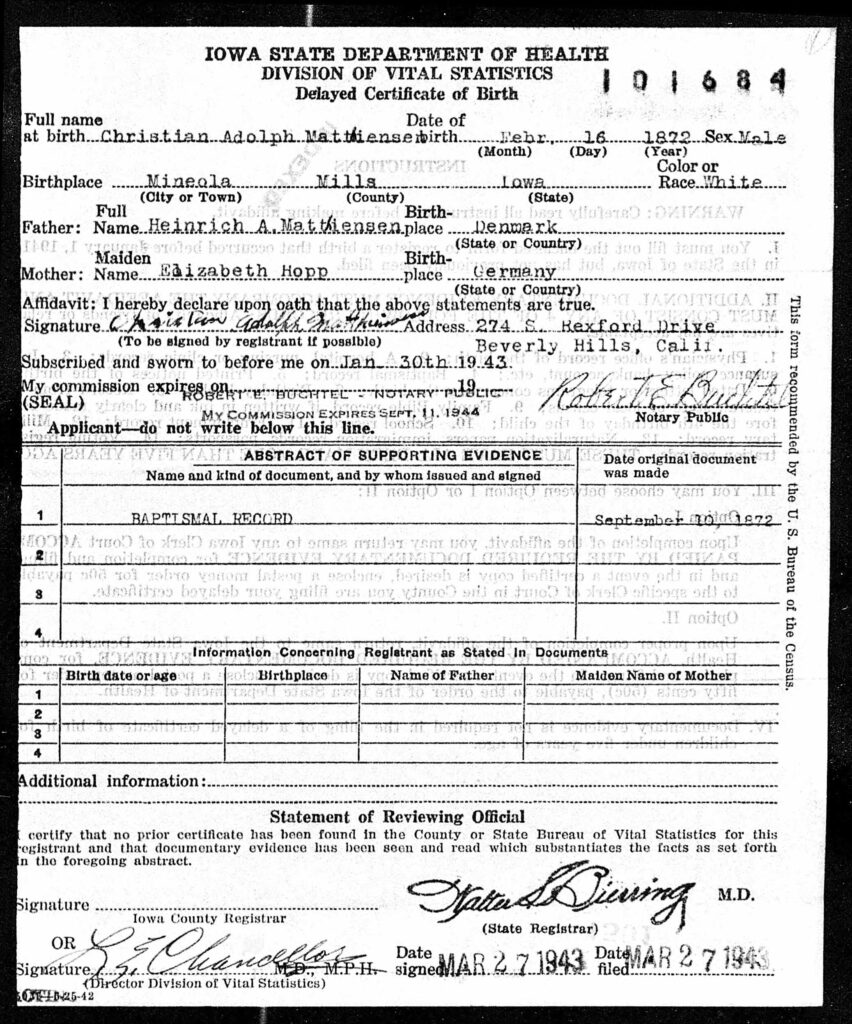
While both Adolph and Lise’s parents immigrated from the disputed Schleswig-Holstein area, their linage is clearly defined; Adolph a Dane and Lise a German. I had always suspected this because of their last names, but this confirmed it. It is also interesting to note that it was a family friend, Robert Buchtel, who notarized the document. Note that by the time Adolph and Lise were applying for their substitute birth documents, they had already moved from Iowa to California. Because he had his baptismal certificate, Adolph was able to apply for his Delayed Certificate of Birth from California.
So, Adolph got his card.
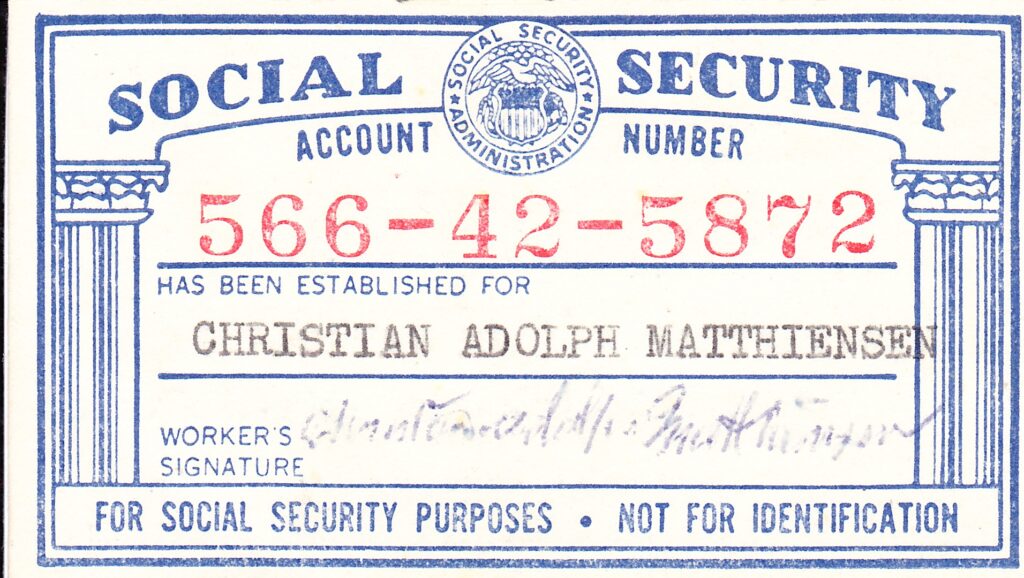
This nearly 80 year old card was in my parent’s belongings, and it is in perfect condition; not one wrinkle or crease in it.
Apparently, Bertha had no baptismal certificate, and so she filed a Birth Certificate Affidavit in Iowa. Don’t know if she traveled there specifically to do this, or it was taken care of in the course of a visit. Note it required the name of who attended the birth (midwife Mrs. Schluyter), and having it signed-off by her older sister Minnie (Schneckloth) Danker.
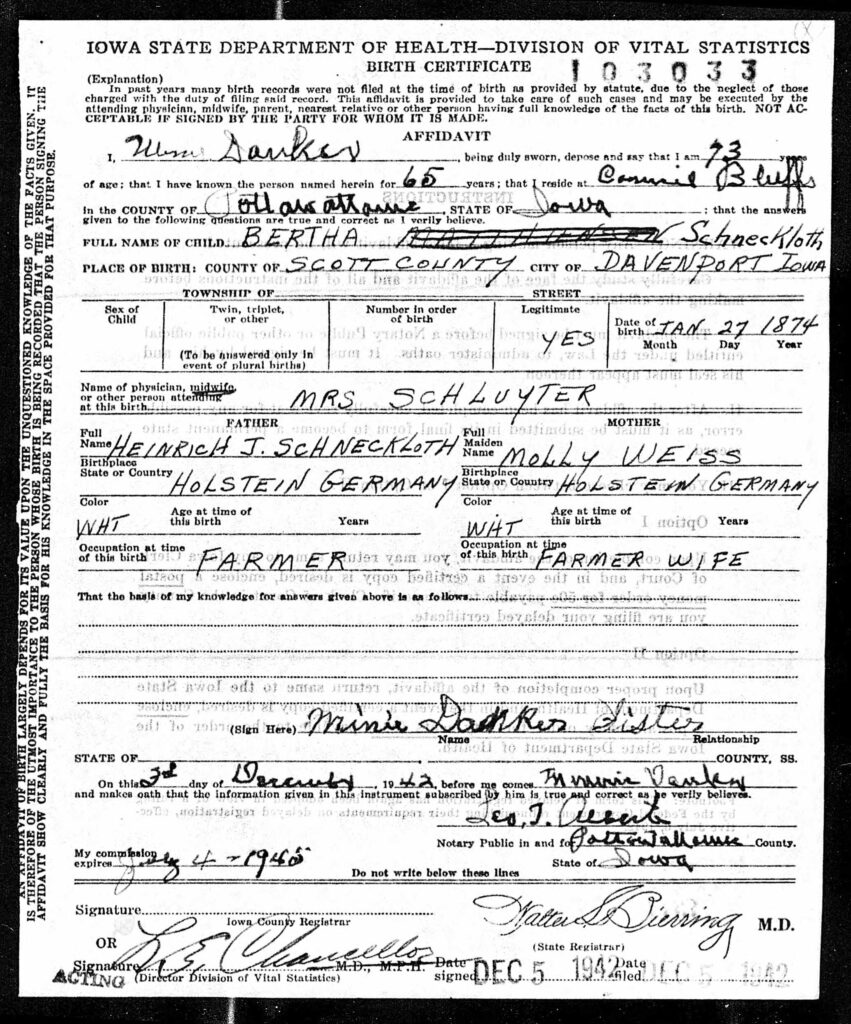
If you compare the dates, it looks like Bertha went to Iowa and took care of her paperwork first (DEC 1942), and Adolph’s was done in California in March 1943. There is a story there, I just don’t know what it was.
I can only presume Lise got her Social Security card, as it was not among the collection of documents.
Bertha
Bertha M. Schneckloth was born on January 27 1874 in Davenport, Iowa. She was the third of eight children (four boys and four girls). Note that Davenport is a city on the far eastern side of Iowa on the Mississippi River; which is the border between Iowa and Illinois. In fact, Davenport is closer to Chicago than it is to Pleasant Township, Iowa (270 miles to the west); the place where she would meet Adolph.
Historical Note: Consider the following. In 1874…
- Ulysses S. Grant was president.
- The ice cream soda was invented by Robert M. Green of Philadelphia
- The jockstrap was invented by C.F. Bennett of Chicago to protect and support bicycle riders (back then they were known as “jockeys”) who were navigating the cobblestone streets that were common to the era.
- The “spork” was invented by Samuel W. Francis.
- The quadruplex telegraph was invented by Thomas Alva Edison, which enabled Western Union to save money by increasing the number of messages the company could send without building new lines.
There were no such things as…
- Telephones in the home
- Phonographs
- Cash registers
- Ballpoint pens
- Incandescent lamps
- Airplanes
- Netflix
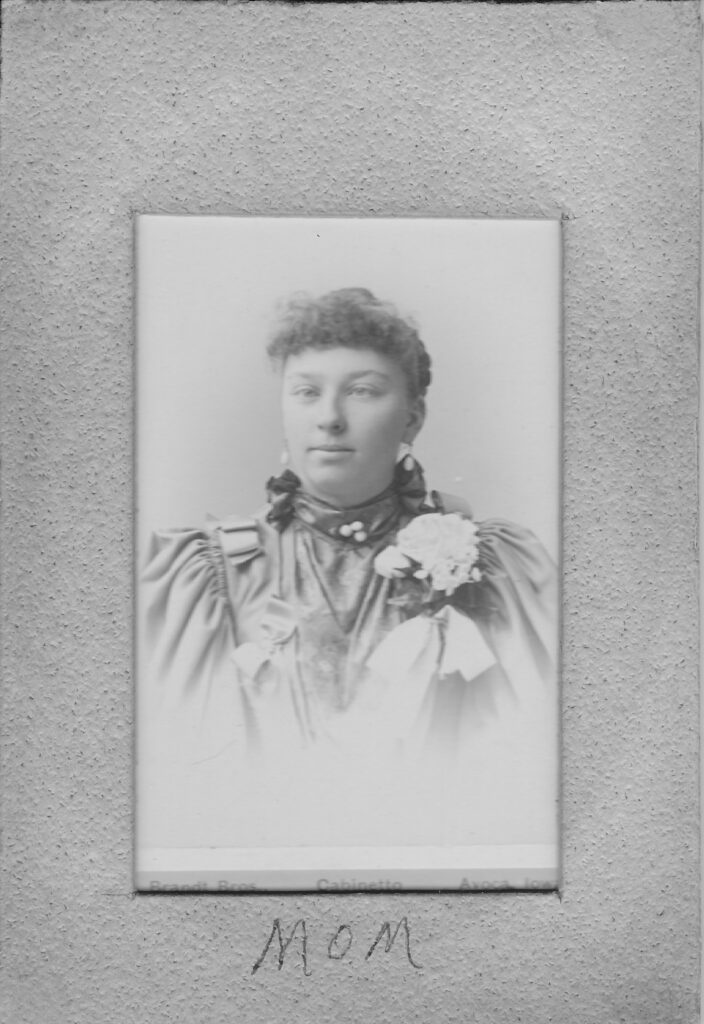

The photo on the left is Bertha. This was in Hilda’s belongings; she has written “Mom” in her own hand.
The photo on the right is the Schneckloth family portrait. It was posted on Ancestry by our distant relative and fellow Ancestry buff “aunttudie33”. The mustachioed gentleman is Bertha’s father, Henry J Schneckloth, and his wife Amalia is seated just on the other side of their youngest (and most infamous of their eight children) Harry. Harry’s story was told in PPP “The Strange and Terrible Story of Harry J. Schneckloth”. Can you tell which one is Bertha?
I’m guessing that in this photo Harry is about 4 or 5 years old. That would make the year of this photo right around 1900; the year Bertha would give birth to Hilda M Matthiensen (Nana).
I have not been able to narrow down just exactly when the Schneckloths moved to the western end of Iowa. The only documentation I could find is an 1895 Iowa census that shows the Schneckloth family living in Neola, Pottawattamie County, Iowa, which is about ten miles from Pleasant Township.
Bertha and Adolph
Adolph (25), married Bertha (23) in Pleasant Township, Iowa on October 7, 1896.
Both Bertha and Adolph’s parents were still living at the time. However, Adolph’s mother, Lise, passed away on April 21, 1897, just six months after Bertha and Adolph were married. She was 57 years old.
Emma
On October 5, 1897, Bertha and Adolph become parents with their first child, Emma Alvina Matthiensen. I have some distant memories of Emma, most of which were from a trip our family took in the early 1960s to visit our relations in Iowa. I was too young to know or appreciate it at the time, but 1960 was roughly 100 years since immigrants August and Lise arrived in America. My memories of Aunt Emma (as we all called her) are all pleasant ones of a warm, kind, always smiling woman. In my mind I can still hear a faint echo of her very distinctive voice; a melodic raspy midwestern intonation, the sound of which spoke in equal parts of an iron-like strength, and the sweet goodness of warm apple pie.
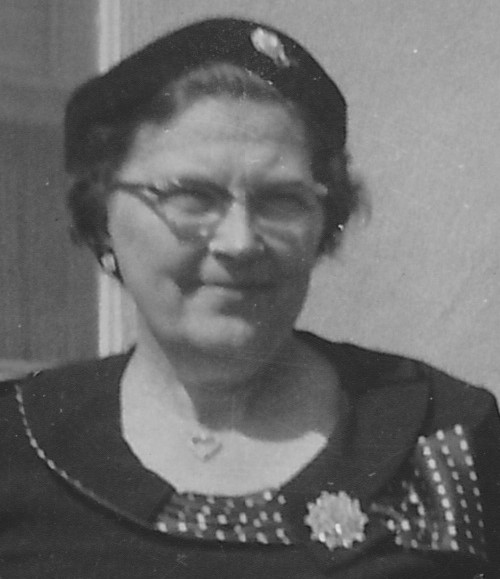
Of Adolph and Bertha’s four children, Emma would be the only one who stayed in Iowa.
Hilda
On May 28, 1900, Bertha and Adolph had their second child, Hilda Marie Matthiensen. Or as my brothers and sisters knew her, Nana.

This is probably my favorite photo of her.
In her later years she moved in with us, and became an authority figure in the household. My two brothers and I would at times take delight in tormenting her. We were not trying to be mean; we were just rambunctious little twerps.
Hilda was an important part of the family for so many years. She watched over and fed us brats when my parents would go out dancing on date night, and she made the best chocolate chip cookies I have ever eaten. To this day, I cannot eat a chocolate chip cookie – my favorite – without thinking of her. We were very close when I was young. It’s hard to explain, and this is probably not the place to try, but she has been a powerful influence on my life, even in these recent years. I have so much to thank her for. But that’s a different story for another time.
Pleasant Township
By June of 1900, Adolph and Bertha were living on a rented farm in Pleasant Township Iowa with 2-year-old Emma, and one month old Hilda. Adolph’s father, August, is also living there with them. August would have been 66 years old when Lise passed away in 1897. If both of them had not already been living with Adolph and Bertha, it certainly would have made sense for August to move in with them when Lise passed on.
Also living with them on the farm was a 21-year-old fellow named Hans Engle, who is listed in the 1900 census as a “servant” and “farm laborer”. Hans immigrated to the US in 1893 when he was just 14. He would eventually leave the farm, marry a woman by the name of Emma Hager, and they would have a daughter together. Ten years later, the census shows Hans working for himself as a “piano tuner”.
August passed away on January 21, 1904. He was 72 years old. His son Adolph becomes executor of his will. That part of the story was told in the PPP “The Matthiensen Family – Part 2 Augusts Will”.
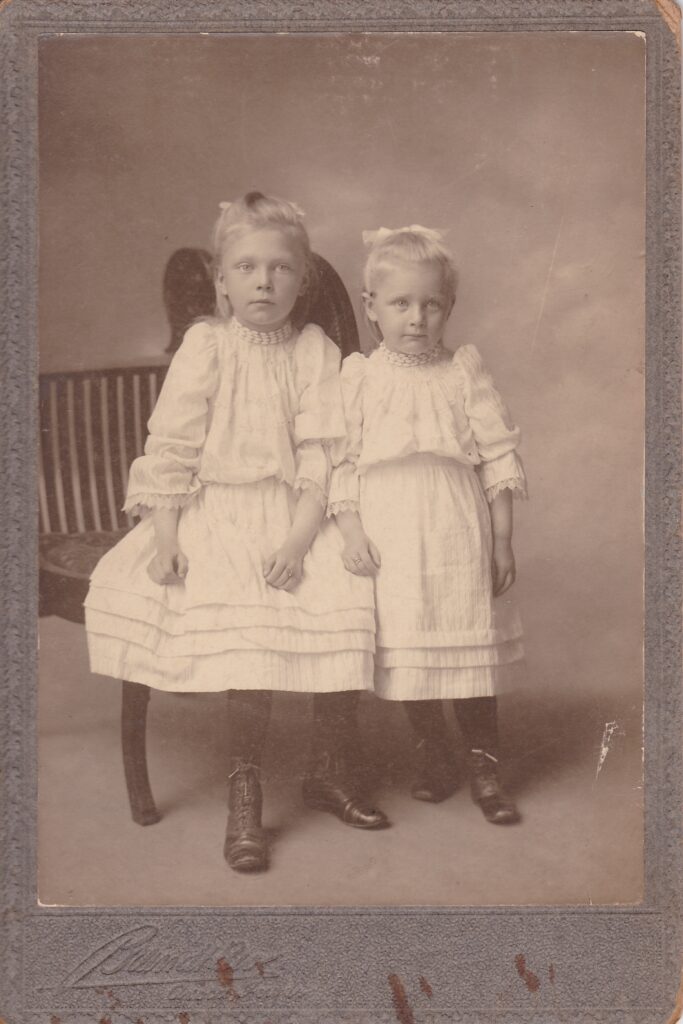
Emma on the left, with her sister Hilda. I figure this was taken in about 1904.
Grant
On December 15, 1904, Bertha and Adolph have their third child and first son, Grant Bentley Matthiensen. It is interesting to note that they were living in Bentley Village at that time. I have to wonder. Did they know a family friend whose family had founded the town, or did they just like the town in which they were living so much that they gave their first son the middle name Bentley?

On January 20, 1905, after the year-long probate of August’s will ended, Adolph is paying remaining debts related to August’s estate. Below, we see one of these payments. It is the same image of the check that I had shared in the aforementioned PPP about August’s Will. It’s a payment to the man who made August’s gravestone, and it’s drawn on Adolph’s account.

There are a couple of interesting things to note here.
The check was written and cashed on the same day. I guess after waiting a year to get paid, the gravestone maker was not going to wait a day longer for his twelve dollars.
The print below Adolph’s name on the check gives us our first hint that Adolph is looking for a career path other than farming. Two things I would love to know; how did Adolph come up with the idea to get into “Fine Wines, Liquors and Cigars”, and just how much demand for such things could there be in rural Iowa in 1905?
The 1910 US Census shows that in May of that year the Matthiensen family are living in a house, that they own, in the area of Bentley village. Adolph is “working on own account” (an old census term that essentially means self-employed) as a “hardware salesman”. In October of 1910, Adolph (38) and Bertha (36) celebrated their 14th wedding anniversary.

The Matthiensen family; Adolph and Bertha, with heir son Grant, and daughters Emma (top) and Hilda. I’m guessing that Grant is about 5 years old, so that would mean this photo was taken in about 1909-10. It is a wonderful portrait of the next Matthiensen generation that reflects their pride and prosperity in what must have been the sunrise of their American Dream.
Virgil
On January 19, 1914, 41-year-old Bertha had her fourth and last child, Virgil Harry Adolph Matthiensen. This is notable. Bertha and Adolph have been married for 18 years. Bertha gave birth to Virgil nine years after Grant, and at an age that – even today – would be considered a high-risk pregnancy. And remember, most births up to this point in time were at home.
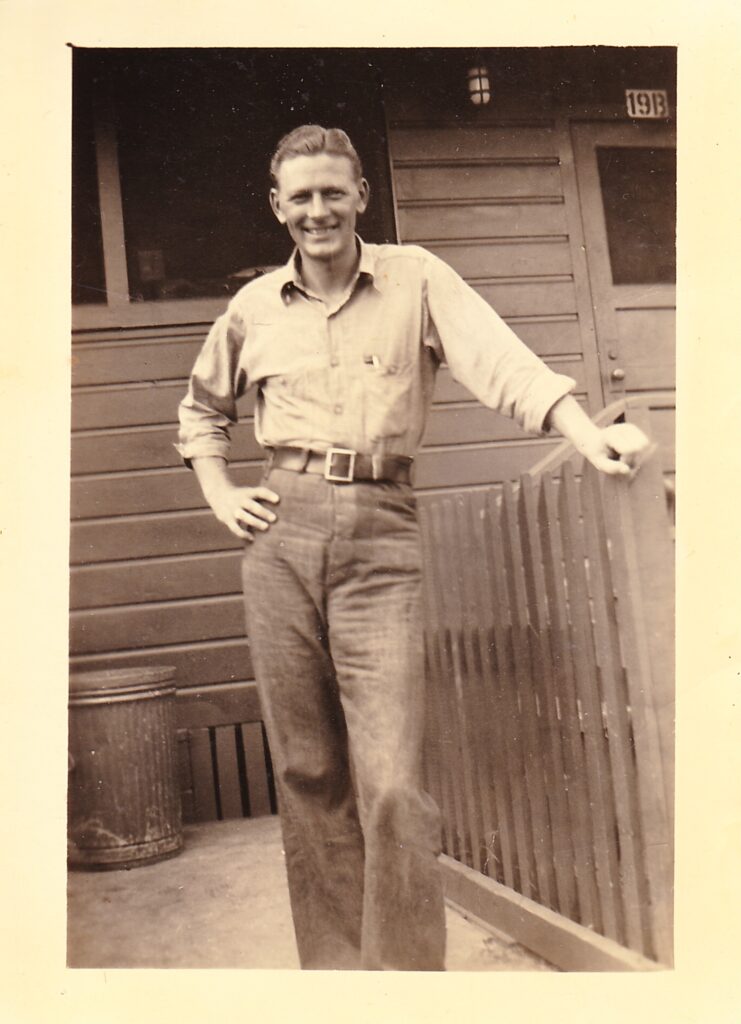
I like this photo of Virgil. I’m guessing it was taken somewhere in the late 1930s to early 1940s. He has that confident relaxed pose and smile of a fit young man in his prime. On the back of this photo his sister Hilda has written “all legs”.
Virgil’s place of birth is listed as Norwalk Township, Pottawattamie, Iowa. Norwalk Township is about 3 miles to the southwest of Bentley. Seems the Matthiensen family is slowly inching their way toward Council Bluffs.
Historical Note: By the beginning of the 20th century, midwives attended about half of all births in the U.S., and physicians attended the other half. Today, only 1% of babies are born at home.
Historical Note: WWI began on July 28, 1914.
Ten months after Virgil is born, on November 20, 1914, his oldest sister Emma (17) married Walter Harry Petersen (21). This was the coupling that would establish the ancestry link between the Matthiensen, Petersen, and (ultimately through Hilda), the McNamara families.
Adolph worked full time as a “clerk” in 1914 and made a total of $500 (equivalent in purchasing power to about $14K in 2022). Adolph has been out of farming for at least 10 years now, but it seems he was still struggling to find his calling.
On May 17, 1915, Emma (Matthiensen) Petersen gives birth to the first of three children; daughter Maxine Genevieve Petersen in Weston, Pottawattamie, Iowa.
Historical Note: WWI ends on November 11, 1918. Also, the Spanish Flu pandemic swept through the United States from February 1918 to April 1920. A few of our family members served in and survived WWI; though we do know that Canadian granduncle Alphe Chouinard was badly wounded in that war (ref. PPP “Frank in the Canadian Army”). As far as I can tell, all family members survived the pandemic as well. Pretty remarkable. This must have left an indelible mark on all the people who lived through these times, but I suppose we will never know the full extent of what they all suffered as a result of these two historic tribulations.
On November 16, 1918, just five days after the end of WWI, Emma (Matthiensen) Petersen gives birth to her second child, Marian Lavon Petersen, in Garner Township, Pottawattamie County, Iowa.
Council Bluffs
Ancestry Note: The State and Federal census reports that are available online are probably the most common source documents for doing this ancestry work. When working in the timeframe beginning about 1900, scanned copies of old phone directories are the next most helpful in filling-in some details of people’s stories. Back in the early days, these directories would commonly list a person’s profession and sometimes list their place of work. These directories also indicate whether the person owns or rents the place in which they live, and they provide other interesting clues. To save room in the listing, this information is often abbreviated, and it’s not always obvious what these abbreviations mean. However, you can find websites that provide definitions for these old directory abbreviations. You would be surprised what one can find by doing a little online detective work.
The 1920 US Census shows that Bertha, Adolph and their family have moved to the big city; Council Bluffs, population 36,162. They are renting a place on 510 Pierce Street. Adolph is 47, Bertha 46, Hilda 19, Grant 15, and Virgil is 6. Hilda is working as a clerk in a dry goods store. Adolph is now working as an automobile mechanic; a profession that he would stick with for the next 15 years until his retirement.
The 1921 Council Bluffs phone directory shows Adolph and Bertha living at 510 Pierce Street. Adolph is working at “Pikes Garage”. Hilda is 21 years old, living with her parents, and working as a clerk at “Benjamin Hirsch”; a clothing store for women at 406 W. Broadway, just a mile down the road from where they live.
Hilda would go on to work as a professional salesperson of women’s clothing in Iowa, and would continue in this line of work after moving to Los Angeles with her husband and son. In fact, her last place of employment was Haggarty’s, a department store in Beverly Hills, where she worked in the women’s wear department until she retired. She was quite the looker and fashion maven in her younger years, and she occasionally modeled.
In 1922 Adolph is working as a mechanic at “Ware & Rihner”, and the family is now renting a place at 914 E Pierce. Ware & Rihner was a “garage” owned by Austin C. Ware and Henry Rihner located at 115 W. Broadway in Council Bluffs.
Hilda is 22 years old, living with her parents, and still working as a clerk at Benjamin Hirsch.
Ancestry Note: The location of the Matthiensen household at 510 Pierce Street is still (in 2022) a residential neighborhood, but the location at 914 E Pierce is now a parking lot for the Methodist Jennie Edmundson Hospital in Council Bluffs.
In 1924 Adolph (52) and Bertha (50) are still renting at 914 E Pierce. Adolph is now working at a garage owned by Howard McDaniel. Grant (20) and Hilda (24) are living at home along with Virgil (10). Grant is working as a “driver”, and Hilda is working as a clerk at “Frank M. Krasne Clothing” at 308 W. Broadway.
The 1925 Council Bluffs directory shows that Adolph and Bertha still living at the same place, and Adolph is still working at the same “garage”. However, Grant is now working as a “clerk”, and Hilda has returned to work at Benjamin Hirsch.
The information above from the phone directory was probably compiled and published before the year 1925 started, so this information does not reflect that on January 28, 1925, 24-year-old Hilda married 27-year-old Gerald Anthony “Mac” McNamara. Some of Mac’s early life was told in the PPP “The Two Geralds”. But there is much more of his story to tell. We will get to that in a future PPP.
In 1926 Adolph and Bertha are still living on E Pierce. However, Adolph is now the proud co-owner of his own auto repair business, “Matthiensen & Williams”, with partner Harvey E. Williams. The shop is located at 101 4th Street in Council Bluffs. Seems like Adolph has found his calling.
Grant (22) is working as a “shipping clerk”, and is living at home with his parents and brother Virgil (12).
The 1927 Council Bluffs phone directory shows Adolph (55) and Bertha (53) with Virgil (14) still living at 914 E Pierce. Adolph now has a new business partner, Glen W. Hammer, and have appropriately changed the name of the business to “Matthiensen & Hammer”. It’s still at 101 4th Steet.
Grant lived at home with them for a time in 1927, and was working as a baker for the Gooch Food Products Company.
Historical Note: Herbert Elmer Gooch established the Gooch Milling & Elevator Company at Fifth and South Streets in Lincoln, Nebraska, in 1908. The business grew over the years, and while it changed ownership, it remained under the Gooch name. The agribusiness conglomerate, Arthur Daniels Midland (ADM), purchased the Gooch Milling property in 1970.
There is evidence that Grant stayed in food-related businesses for most of his life.
Grant, Ardieth, and Adolph and Bertha’s Grand Tour to LA
On August 22, 1927, 23-year-old Grant married 23-year-old Ardieth Cleo Maxfield, a “beauty operator”.
I had no idea that Uncle Grant was married before he was married to Aunt Edna. And I might not have ever known had I not stumbled upon this postcard among the family keepsakes.
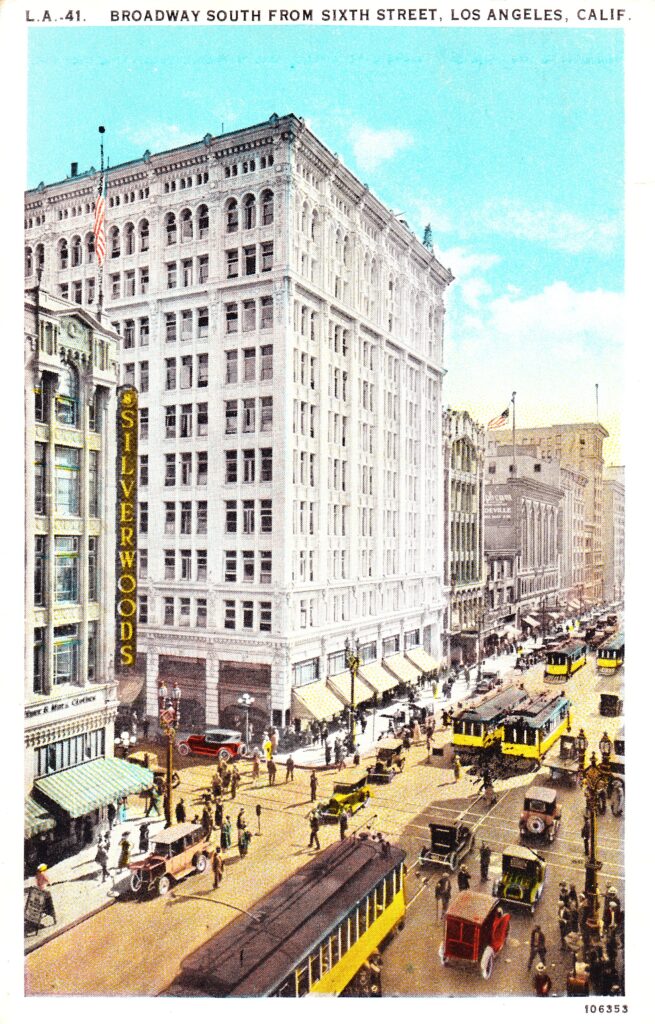
The photo on the front of the postcard is a wonderful peek at what contemporary Los Angeles looked like in 1927.
Historical Note: Silverwoods was a men’s clothing store chain founded in Los Angeles in 1894 by Francis Bernard (F.B. “Daddy”) Silverwood, a Canadian-American. He was a colorful character variously described back then as one who was “frequently covered in the newspapers”, a “songster” composer of popular songs, and a Shriner. There were other store locations, but this one was his flagship store that he had built in 1920 (at Broadway and 6th).
Adolph sent this postcard to his sister, Bertha Dorothy (Matthiensen) Claussen and her husband Hugo. I wrote a bit about her in the PPP “The Matthiensen Family – Part 1 The Immigrants”. The back of the postcard tells the tale.
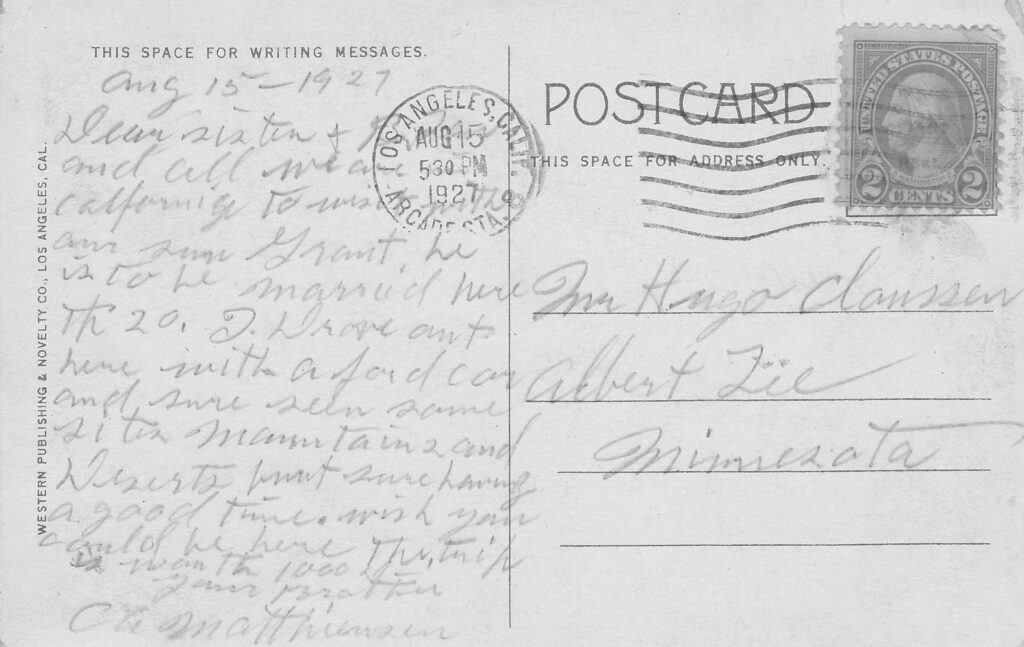
On the postcard, dated August 15 1927, Adolph says that he and Bertha drove “out here” to California “with a Ford car” to visit their son Grant, who is to be married on the 20th (Los Angeles marriage records show it was the 22nd).
All the records I have seen make it pretty clear that Grant and Ardieth were both living in Council Bluffs when they met. Which makes it interesting that they traveled to, and got married in, Los Angeles. Why they were in Los Angeles, and why they chose to get married there, is unknown.
I do not know how this postcard, sent to the Claussen family who were living in Minnesota at that time, got into my parent’s belongings. But it was a fascinating find.
Adolph notes that he and Bertha “sure seen some sights mountains and deserts” and that they are “sure having a good time”.
If they were taking that trip today in 2022, Adolph (55) and Bertha (53) would be driving a 1,557-mile trek that would have them climb the Rocky Mountains to Denver, then on through Utah and past Zion National Park, through Las Vegas (such as it was back then), through the Mojave Desert, San Bernardino, and on into Los Angeles.
Historical Note: Nevada legalized gambling in 1931.
For the sake of discussion, let’s presume they drove a new model Ford of the day. This is what it would have looked like.
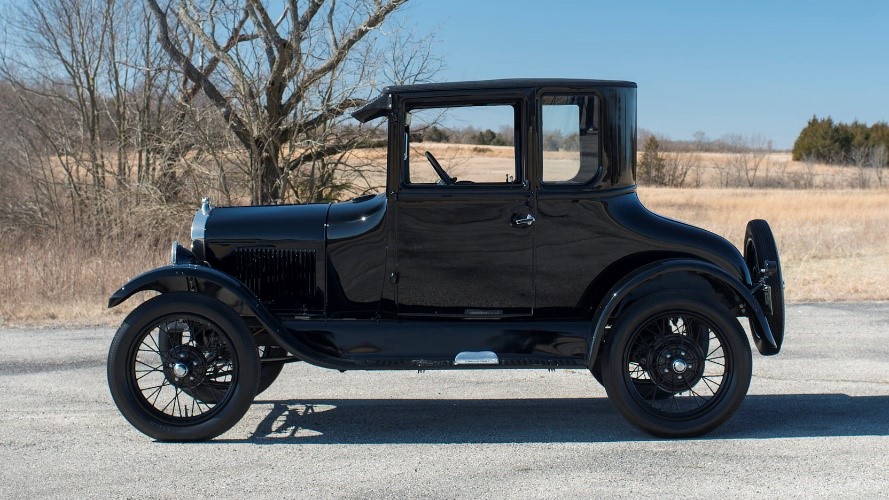
Ford 1927 Model T Coup (photo from internet)
Keep in mind, the one they drove may not have been as new as this one. Top speed of this little honey is 45 miles per hour. So, if they had floored it without stopping, it would have taken (best case) over 34 hours of driving time to make this trip. I’m guessing they were not doing the top speed of 45 mph going up and over the Rockies. What else is surprising is that these relatively small light cars, at least by today’s standards, got terrible gas mileage; about 20 miles/gallon. So, the range on one tank was only about 155 miles.
And they did this trip in August!
Historical Note: Air-conditioning in automobiles would not be a thing till the 1940s.
What a road trip! Bertha must have been supremely confident in Adolph’s abilities as a car mechanic.
As near as I can tell, Grant and Ardieth were just visiting Los Angeles, and they soon returned to live in Iowa. The marriage did not last long, and it appears they had no children.
Gerald Robert (“Bobby”) McNamara
On October 10, 1927, not long after Bertha and Adolph return from Los Angeles, daughter Hilda (27) gave birth to her one and only child, Gerald Robert McNamara (my Dad), in Council Bluffs, Pottawattamie, Iowa.

A very young Gerald Robert McNamara

This is a scan of the original bill for Hilda’s maternity stay in the hospital. She hung onto this memento of her only child’s birth all these years. I believe this may represent the first hospital birth in this branch of the family tree.
Historical Note: In 1900, only five percent of all births occurred in hospitals. In urban areas, the shift from home to hospital occurred quickly. By 1935, about 75 percent of urban births occurred in hospitals, and nearly all occurred in hospitals by 1950.
The bill, $62.50 for a 15 day stay, was paid on the day of discharge. Results of online research tells me that two weeks was an average length of stay for a birth at that time. Some attribute the long stay to a shift to urban life. In rural areas, where home births still occurred, it was more common to have extended family living nearby. They would pitch-in to help in those first weeks after the birth. During this period, where folks started moving off the farm to the city, this was not the case. So the extended stay in the hospital worked as a substitute for help that would normally be provided by local family.
In 1928, Adolph, Bertha and their son Virgil (14) are still living on E Pierce, and Adolph still owns his auto repair business with Glen W Hammer.
On February 19, 1928, Emma (Matthiensen) Petersen gives birth to their third child Walter Harold (“Pete”) Petersen, in Council Bluffs, Iowa. In later years, Pete would eventually move to California, and he and his family are still here in California today.
On December 16, 1929, Betha’s mother, Amalia (Weiss) Schneckloth, passed away. She was 78 years old.
The End (for now)
This is a good stopping point, but it is not the end of their story. We leave Bertha, Adolph and their children all comfortably living in Iowa. But an event would come along that would change all that. We will pick up on their story in Part 2 – California.
Happy spring holy days to all.
MMc
This is just fascinating, especially all the family info but also all the historical facts that really put everything in perspective. Very interesting read, thank you ❤️
Thank you sweetie!
I’m so impressed with all of the work that you have put into this. I love reading about our relatives! I also love the history of the times. It surely makes me appreciate all that we have and all that my family helped to make my life what it is today. Thanks so much.
Thanks Connie! I was hoping that folks would appreciate the “notes”. For me, it does make the story richer.
Thanks for this installment Mike. I’m looking forward to learn more about these folks soon.
Cheers,
Paul
Thanks Paul. Stay tuned…